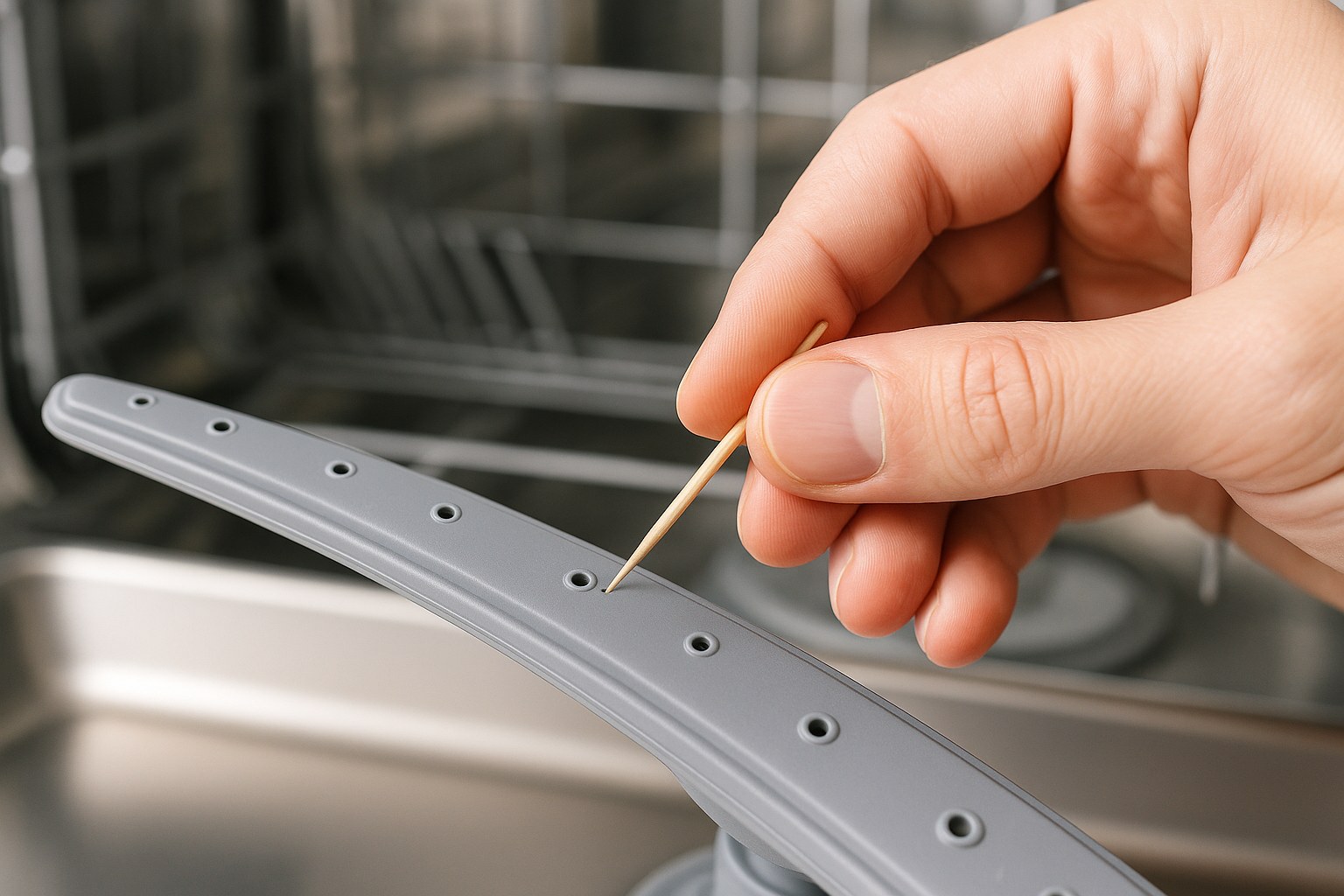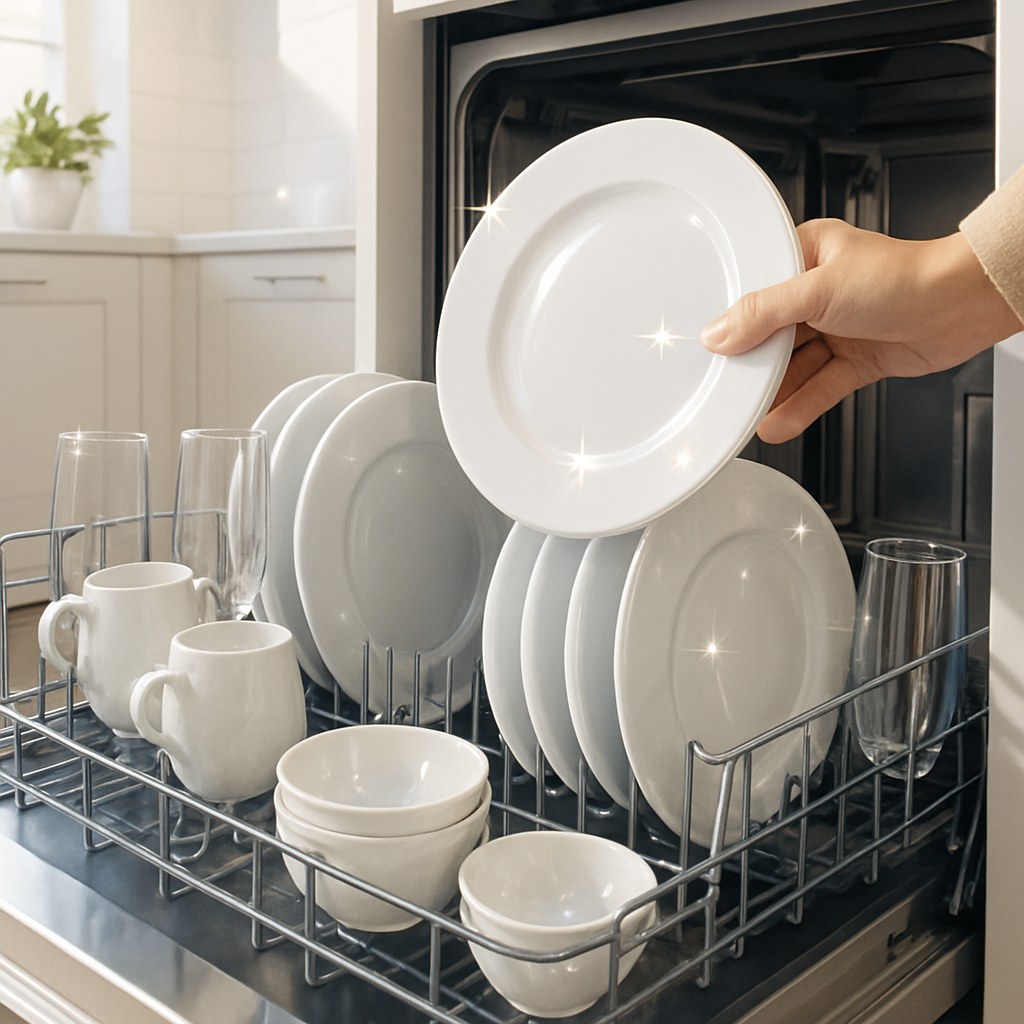There are few kitchen frustrations more disheartening than opening your dishwasher after a full cycle, expecting sparkling clean dishes, only to be greeted by greasy plates and bowls still speckled with last night's dinner. If your dishwasher is leaving food particles behind or your glasses are coming out cloudy, don't rush to call a repair technician just yet.
The good news is that most of the time, a dishwasher not cleaning properly is caused by a few simple, easy-to-fix issues. From improper loading to a clogged filter, you can likely solve the problem yourself in under an hour with just a little bit of troubleshooting.
We're here to walk you through it, step-by-step. Let's diagnose the problem and get your dishwasher back to doing its job effectively.

Why Is My Dishwasher Not Cleaning Properly? Common Causes
Before we dive into the fixes, it helps to understand what might be going wrong. Your dishwasher is a surprisingly complex machine, but the reasons for poor performance usually boil down to a handful of culprits:
- Improper Loading: Overcrowding the racks or blocking the spray arms is the number one cause of dirty dishes.
- Clogged Spray Arms: The arms that spray water can get blocked with food debris, preventing water from reaching all your dishes.
- Dirty Filters: A clogged filter means dirty water is being recirculated onto your dishes instead of being drained away.
- Low Water Temperature: Water needs to be at least 120°F (49°C) to effectively dissolve detergent and cut through grease.
- Appliance Age: Older dishwashers (10+ years) can lose their cleaning power and become less efficient.
Now, let's start with the most important question you should ask before you begin troubleshooting.
First Things First: How Old Is Your Dishwasher?
Before you start taking things apart, it's wise to check the age of your appliance. Like any major appliance, dishwashers have a finite lifespan. According to experts like Consumer Reports, the average dishwasher lasts about 10 years. If your machine is older than a decade, it may be more cost-effective to replace it rather than sink money into repairs.
How to Check Your Dishwasher's Age:
- Find the Data Plate: Open the dishwasher door and look for a sticker or metal plate, usually along the edge of the door or on the inner frame of the tub.
- Locate the Manufacture Date: The plate should list the model number, serial number, and often, the manufacture date.
- Decode the Serial Number (If Needed): If there's no clear date, you can often determine the age from the serial number. A quick search for your brand's serial number format online will usually give you the answer.
- Do the Math: If your dishwasher is more than 10 years old, it's likely less efficient, uses more water and energy, and is more prone to failure. While you can still try the fixes below, keep in mind that a replacement might be the best long-term solution.
If your appliance is under 10 years old, let's move on to the troubleshooting steps!
Step-by-Step Guide to a Cleaner Dishwasher
We'll start with the simplest fixes and work our way to the more involved ones.
Step 1: Master Your Loading Technique
It might sound too simple, but how you load your dishwasher has a massive impact on its performance. If water and detergent can't reach every surface, your dishes won't get clean.
- Don't Overcrowd: Give your dishes some breathing room. Stacking plates on top of each other or cramming in too many items will block the water flow.
- Face Dishes Inward: Place plates, bowls, and dirty pans on the bottom rack with the soiled side facing the center, toward the spray arm.
- Top Rack for Cups and Glasses: Place glasses, cups, and small bowls upside down on the top rack, nestled between the tines so they don't move around.
- Check for Blockages: Before you start a cycle, give the upper and lower spray arms a gentle spin with your hand. If they hit a tall panhandle or a bulky utensil, rearrange the items until the arms can spin freely.
- Utensil Smarts: Mix up your silverware in the utensil basket, placing some handles up and some down. This prevents spoons from "nesting" together and blocking water.
After reloading properly, run a normal cycle. If your dishes come out clean, you've found the culprit! If not, it's time to dig a little deeper.
Step 2: Inspect and Clean the Spray Arms
The spray arms are responsible for shooting pressurized jets of water to clean your dishes. Over time, the small holes in these arms can become clogged with food particles or mineral deposits from hard water.

How to Clean Your Spray Arms:
- Power Down: For safety, unplug the dishwasher or turn it off at the circuit breaker.
- Remove the Racks: Take out the bottom rack completely. For the top rack, you may need to pull it out and press release tabs on the rails to remove it.
- Remove the Spray Arms:
- The lower arm usually lifts off or unscrews counter-clockwise.
- The upper arm is typically held in place by a clip or locking nut.
- Clear the Blockages: Hold the arms under warm running water. Use a toothpick, pin, or small brush to gently poke out any debris stuck in the spray holes.
- Give Them a Vinegar Soak: For stubborn mineral buildup, soak the arms in a sink or basin filled with white vinegar for 15-20 minutes. The acid will help dissolve the deposits.
- Rinse and Reinstall: Rinse the arms thoroughly with water and reinstall them, making sure they are securely in place.
- Restore Power and Test: Put the racks back in, restore power, and run another cycle.
If this fixed the issue, congratulations! If the dishes are still dirty, let's move on to the filter.
Step 3: Clean the Dishwasher Filter
This is one of the most important and most overlooked maintenance tasks. The filter's job is to catch large food particles, but if it gets clogged, that dirty water just gets sloshed back onto your dishes. Most manufacturers recommend cleaning the filter at least once a month.
How to Clean Your Dishwasher Filter:
- Locate the Filter: Remove the bottom rack. You'll find the filter assembly on the floor of the dishwasher tub, usually a cylindrical piece that twists to unlock.
- Remove the Filters: Most models have two parts: a cylindrical upper filter and a flat coarse filter underneath it. Twist the upper filter (usually counter-clockwise) and lift it out, then lift out the coarse filter.
- Wash the Filters: Rinse both filters under warm running water. Use a soft brush and a little dish soap to gently scrub away any greasy residue or stuck-on food. Avoid using abrasive sponges, which can damage the fine mesh.
- Clean the Filter Well: While the filters are out, wipe the area where they sit inside the dishwasher with a damp cloth or paper towel to remove any gunk.
- Reassemble: Place the coarse filter back first, ensuring it lies flat. Then, insert the upper filter and twist it clockwise until it locks firmly into place. You should feel or hear it click. An improperly seated filter won't work correctly.
Once the filter is clean and locked in, run a wash cycle and check the results.
Step 4: Check Your Water Temperature
Dishwasher detergent is formulated to work best in hot water. If your water isn't hot enough, the soap won't dissolve properly, and grease won't be broken down effectively. The ideal temperature is 120°F (49°C).
How to Check and Adjust Water Temperature:
- Run the Tap: Before starting the dishwasher, run the hot water at the kitchen sink for a minute or two until it's as hot as it gets. This purges cold water from the pipes.
- Measure the Temperature: Use a meat or digital thermometer to check the temperature of the water coming from the tap.
- Adjust if Necessary: If the temperature is below 120°F, you may need to adjust your home's water heater thermostat. Caution: Be careful not to set it too high (above 125°F) to avoid scalding risks. Consult your water heater's manual for instructions.
After ensuring your water is hot enough, run a cycle. This simple trick often makes a huge difference.
When It’s Time to Call a Professional
If you've tried all the steps above and your dishes are still coming out dirty, you may be dealing with a more complex mechanical or electrical issue. Problems like a faulty water inlet valve, a broken heating element, or malfunctioning sensors require an expert.
The cost of hiring an appliance repair technician can vary, but you can typically expect to pay between $100 and $300 for a diagnosis and repair, depending on the parts and labor required.

Take Control of Your Home Maintenance with Casa
Fixing a dishwasher is an empowering DIY project that can save you time and money. With a little patience and the right guidance, you can tackle many common household issues on your own.
For more expert-led repair guides, maintenance reminders, and a direct line to vetted professionals for the jobs you can't handle yourself, download the Casa app today! Casa is your all-in-one partner for home care, making it easy to keep your home running smoothly. Stop letting dirty dishes win and start taking control with Casa.


